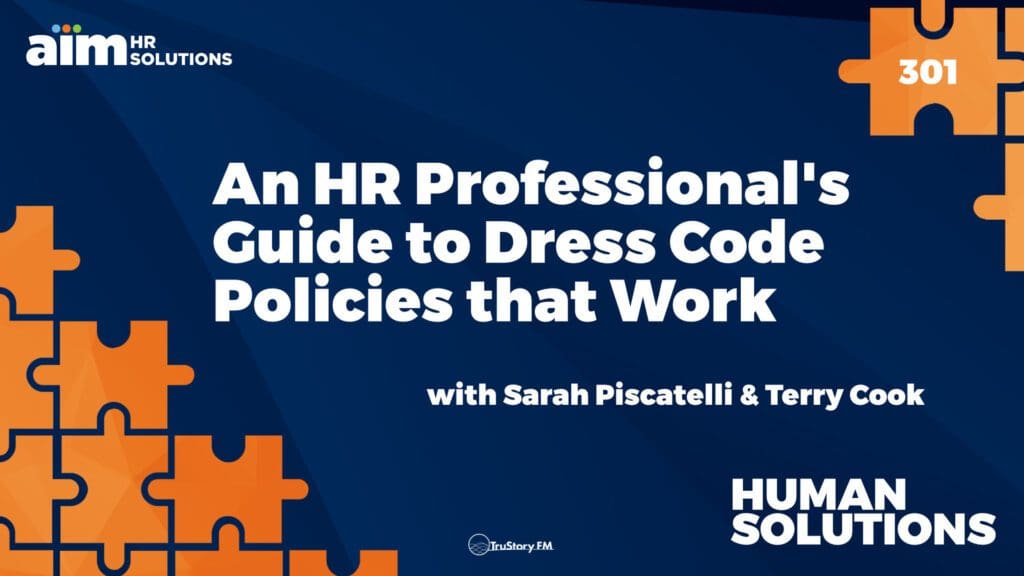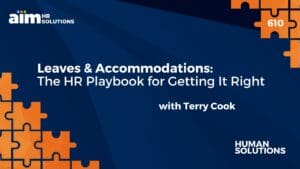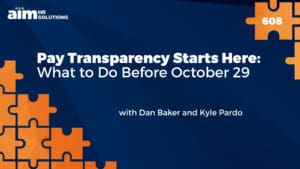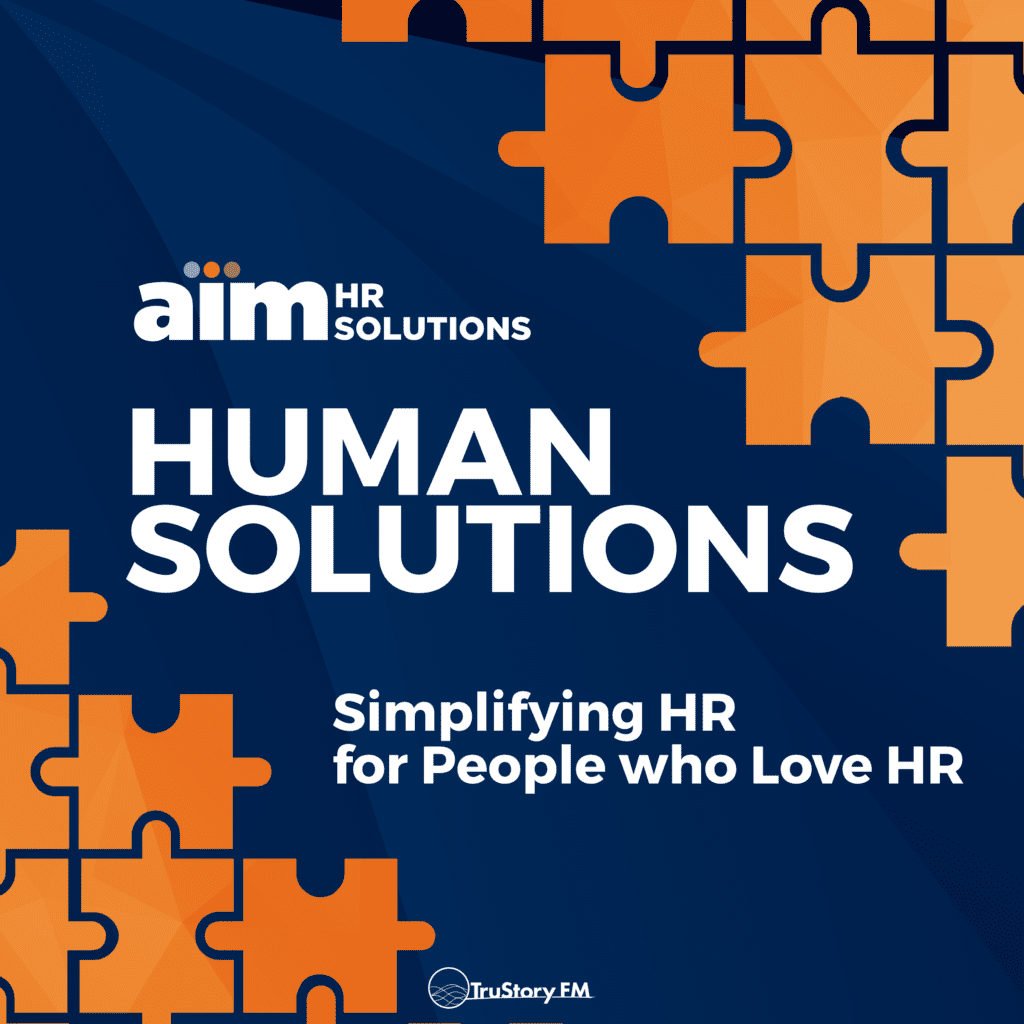Are you tired of feeling like the fashion police when it comes to enforcing a dress code in your workplace? As an HR professional, you know that dress code policies are essential to maintain a professional and safe workplace. But it’s not always easy to balance compliance with laws and regulations, individual expression, and organizational image. Terry Cook and Sarah Piscatelli join Pete Wright to share the tools of a smart, safe, and inclusive dress code policy for your organization.
From understanding the legal implications of dress codes to navigating tricky situations like religious exemptions and race discrimination, our experts, Terry Cook and Sarah Piscatelli, will share their knowledge and experience. So, get ready to put your best foot forward and tune in to this episode for a dose of fun, informative, and creative insights that will make dress code policies a breeze in your workplace.
Episode Transcript
Pete Wright:
Hello everybody, welcome to Human Solutions. Simplifying HR for people who love HR, from AIM HR Solutions on True Story FM. Are you tired of feeling like the fashion police when it comes to enforcing dress code in your workplace? Hey, on Zoom meetings, are you tracking what tops people are wearing? That’s all right. We’re going to talk all about fashion, HR as fashion police, the works. With our real resident fashionistas ourselves, we have Terry Cook and Sarah Piscatelli on the show this week. I’m really excited to talk to y’all about fashion.
Okay. It’s not really fashion we’re talking about, because we’re not judging people’s fashion so much as we are talking about dress code. Terry, Sarah, welcome to the show this week. Glad to have you both here. How did this end up on our editorial calendar for a podcast this season? Terry, do you want to start?
Terry Cook:
Sure. I think it’s definitely been coming up more and more since the pandemic. Since we had people working remotely, then hybrid, some in person, dress code has changed drastically in the workplace. So a lot of companies actually have been reading recent articles that when they want somebody to come back to work, some of the argument employees make is when they’re at home, they’re saving money on clothes, new clothes, dry cleaning and all of that. And then the workplace itself has become a little more informal. A lot of our workspaces have changed. They’ve become smaller in size, less formal meetings, more phone, Zoom meetings, different Teams meetings. I think it’s been more prominent since the pandemic itself that’s caused us to have these conversations. Sarah, would you agree?
Sarah Piscatelli:
I would, yeah. I was certainly trending that way. Business casual was getting ever more casual, but now I think, I have even heard of companies that have revised their dress code in order to get people back to work. Trying to get people back in the office, so the rules have really been relaxed.
Pete Wright:
Relaxed rules seems like maybe it’s okay, we have a broader spectrum of things that we can wear to work. Why is this a problem. Sarah, why is this a problem?
Sarah Piscatelli:
It’s not necessarily a problem, but I would advise that you have some sort of a dress code, so that people aren’t wearing things that are entirely inappropriate for whatever setting you’re in. They might come in with a T-shirt that has an offensive slogan on it, something like that. You’d like to be able to say, “You’re going to have to change, cover it up, go home,” whatever. There really is a need to have some general rules around it. And the policies that we have, model policies have seen a lot in handbooks that I’ve reviewed, a lot of them will just specify things that are not acceptable in the workplace. Open-toed shoes, shorts, things like that, so they just at least have some basic rules on what you can and cannot wear into the workplace.
And the reason that the company wants to do that, certainly we’ll get into what, safety is in some cases the reason for a dress code, you need employees to be safe on the job, but also to project the image that the company wants to project. Even on Zoom, but also when people are in the office and coming in for meetings, things like that, you want to set a certain tone. And companies, employers are allowed to do that and they should do that.
Pete Wright:
I’ve been podcasting for a long time, and over the pandemic I noticed that even our guests who join us on shows tend to be a little bit more lax, personally, with their attire. As we are accustomed to seeing just a torso of one another, we really get to know each other’s torso. The number of times I have seen people stand up to let the dog in or out of their office and be wearing their boxer shorts, is non-zero, y’all. It is non-zero. And I wonder how, are you seeing these kinds of stipulations being addressed in dress codes? Must wear pants if on camera, kind of thing?
Sarah Piscatelli:
I really haven’t. Most of the employers that do have a dress code-
Pete Wright:
Sarah, would you please start now today? Could we? I’ve been looking for somebody to take up this cause, must wear pants.
Sarah Piscatelli:
Well, you can’t muzzle their children or anything else, I guess it kind of goes along, the unexpected occurrences on Zoom calls. Children, pets, things like that. No, I haven’t. The companies that are more concerned with dress code are ones that have people coming in. So far, I haven’t seen a lot of rules around Zoom calls and dress.
Pete Wright:
Terry, let’s talk about some of the actual things you are considering when it comes to working with AIM member companies, and helping them think about what are the exemptions to dress codes. What are the considerations you have to have when building a dress code policy that works for, that is inclusive?
Terry Cook:
That’s a great question, because things have changed with that as well. Not too long ago, Massachusetts did pass the Crown Act for people. So you have to take into consideration that… and the Crown Act is creating a respectful and open world for natural hair. So what they’ve done when they did that in workplaces or schools, primarily schools or public accommodation settings, is that they’re saying that that’s covered under race. So in other words, that’s going to be a potential category for racial discrimination, if for some reason somebody puts something in their dress code policy related to the hairstyles that are allowed.
I haven’t personally seen in human resources in all my years, too many policies that surrounded specifically around hair, as much as it was clothing, neat appearance clothing, and I’m sure we’ll talk about later, the dreaded hygiene piece of a dress code. I think you have to take into consideration that there always could be laws that are going to be impacted by dress code policies. There’s always potential exemptions, such as religious or disability exemptions that you have to consider when you’re looking at a dress code policy. All of those are very, very important to start off when you’re looking at a dress code policy creation in your workplace.
Pete Wright:
Well, you brought it up, we have to talk about hygiene. What are the hygiene considerations that we need to put in our dress code policy, Sarah?
Sarah Piscatelli:
Generally must be clean, well groomed, things like that. That’s fine to put that into a dress code. I’d be fairly general about that. I don’t think you have to have bathing requirements, daily bathing should be assumed. But I would put it in fairly general terms, because we do often hear of companies where they have somebody who has poor hygiene. It does become offensive to other people that work… you at least have to have the right to speak to an employee. Your dress code is the basis for that, it’s dress, grooming, et cetera. It covers more than just attire. And you have to be able to speak to somebody about that, and make sure that they address it when that does happen.
Terry Cook:
Right. And I think when it comes to, I know I’m going back into the exemptions, Pete. But with safety as an example, when you were asking about the exemptions, there are scenarios where somebody has a requirement, even though there’s a safety equipment requirement, that they need an exemption due to a medical condition. So an example I ran across an HR a few times, when I was requiring steel towed shoes. There’s people that might have a medical condition that does not allow them to have steel toe, any kind of steel or something like that touching their skin.
What was interesting is, we did some research because we were in a manufacturing setting that required that for their protection. And what we ended up doing, is finding something that they could put over the outside of their shoe that would protect their foot equally, but it wouldn’t impair their medical condition because it wouldn’t touch their skin. So, it was a safety accommodation that was requested and that we were able to meet. That I think is an important example to cite, because as Sarah was talking about policies and different pieces to put in there, you just have to be reasonable and open, as Sarah mentioned, to having those conversations. Because accommodations for disability do come up during some of these dress code discussions.
Pete Wright:
Well, and it seems like the more you actually specify in a dress code policy, the more potentially you could tie yourself in knots around trying to justify it, or rationalize it, right? Especially when it comes to personal expression. Now we’re not talking about health and safety, but what about just this is my identity, this is how I express myself, I should be able to do that at work? How do you navigate what I imagine could be complex seas?
Sarah Piscatelli:
An employer does have the right to limit. It isn’t like a governmental entity restricting what you can say and do, et cetera. They can make rules about this. One good example in Massachusetts going way back was from 2004. It was a Costco employee, they had a dress code that included you could not wear facial piercings while on the job. And she filed a religious discrimination claim. She belongs to the Church of Body Modification. Yes, and the court took the case up. They never questioned, one, the legitimacy of that as a religion, or the sincerity of her beliefs. Yet they focused on what Terry was just talking about, this kind of interactive dialogue. Okay, we’re going to have to find an accommodation for this.
And the company, Costco had said you can just cover it up with a bandaid while you’re working, and that wasn’t good enough for her. And I believe the court’s decision was based on the fact that the employee wasn’t being reasonable about that. I don’t know where exactly on her face, but she could have put a bandage over her eyebrow or even her nose, if needed to, just get through the work day. And she wouldn’t agree to that at all. So there has to be this back and forth, where both the employee can suggest accommodations, the employer can suggest accommodations, you find something that works.
Pete Wright:
So where do those conversations end up? It sounds like you’ve just painted a picture of an unreasonable, potentially unresolved, or resolved by way of, I guess the employee could say I’m going to work somewhere else. That’s one way to do it. But how do these conversations around enforcement normally go? We don’t need to go to court, but if I’m listening to this as an HR pro, how do you guide me in having what could be these sensitive conversations about enforcement of the policy, with an employee that is outside of that policy? Terry, you want to start?
Terry Cook:
Sure. As Sarah mentioned, the interactive discussion is the most important piece. It’s just important to not a address any of these things that you might have see in dress code policies so strictly that you’re not willing to listen, and willing to understand what their perspective is, where they’re coming from. Because it could be something that could be resolved. As Sarah mentioned, you have to be open to the fact that there might be accommodations that are required, as I mentioned earlier, it might be disability, it might be a medical condition. It could be anything. You just need to be open. I guess the best thing I can say is to not act quickly, but to listen before you make decisions on how you’re going to react to a complaint, or something that somebody may have seen.
Sarah Piscatelli:
I agree, yes. And private conversation with them, sometimes they might even agree and say, “Okay, I probably shouldn’t have worn that.” If they’re wearing something that’s inappropriate. Also, a caution to employers is to be sure that if you enforce consistently, don’t pick and choose. If you’re allowing 25 year olds to come in wearing things that are more revealing, sleeveless and low cut or whatever, then when somebody who’s 65 comes in wearing the same thing, that isn’t the time to pull out the dress code, if that’s how everybody has been dressing. You really do have to be consistent in your enforcement of the dress code.
Pete Wright:
Have either of you worked under a restrictive dress code policy?
Terry Cook:
I have in manufacturing, because it’s really important from the safety perspective. Whether you worked out on the floor or you worked on the office, you had to be mindful of safety issues when you went out onto the floor. You weren’t wearing open toed shoes, you were either wearing steel toed shoes, or you were staying within a certain path of what they considered a safe place to walk. And the other piece was a lot of the manufacturing employees had to be very mindful of very loose clothing, or loose hair that could get caught into a machine. That would be more restrictive as well. I haven’t worked in an environment where they really were specific about what you wore in your position. If you had to wear, for example, like a suit and tie kind of dress code, I haven’t been in those. It was very much you need to be professional looking, because you’re encountering customers on a regular basis. And then a lot of the restrictions fell more on the safety side.
Pete Wright:
Just as an aside, Terry, are there any restrictions in and around use of uniforms?
Terry Cook:
When it comes to the State of Massachusetts, employers have to be mindful that they’re not allowed to charge the employees for their uniforms or the cleaning of their uniforms. These are different than the federal laws, so I think a lot of employers that I’ve spoken to have been very tempted to say, “I’m going to charge all of my employees to purchase the uniforms, to clean the uniforms. And then if they leave, 10 years later, I’m going to charge them full price for that uniform they didn’t return.” Which obviously wouldn’t go over well in Massachusetts, but also in general, I don’t think from 10 years of washing that your uniform is still worth the same thing it was when you bought it, just like any clothing. I think there are some landmines for employers to be very aware of when it comes to trying to charge people for uniforms.
Pete Wright:
My last example of working in an organization with a more restrictive dress code, it was almost an undocumented dress code for a time. And then the CEO who had a more traditional background, came out and said, okay, men are in suit and ties, women are in dresses. There’s just dresses with some sort of hose or stocking, and traditional heels, to look the part of a feminine businesswoman. That was the whole ideal. And we were at a time when the women on staff did not care for that. And we ended up seeing not an individual pushback, not an individual case, but a case of the women naturally banding together and pushing against all of those boundaries. You’re in HR, you start seeing that happen, and you know that it’s the CEO that has this rather, let’s say parochial standard of dress in an organization. How do you guide toward mediating between these two forces?
Sarah Piscatelli:
I haven’t seen as many gender-based restrictions. That seems to have gone away, but at the time, and the law still stands that they still can be enforced, where it’s based on gender, different rules, as long as it isn’t more burdensome on one gender versus another. Somebody has these expensive requirements where they’re going to have to do lots of dry cleaning, for example, or buy lots of makeup and nice clothes. Meanwhile, the guys are wearing jeans and t-shirts. Those clearly would be unacceptable, they look at the burden. But I think companies themselves, they’re becoming much more relaxed. I know that I read about an airline recently and the flight crews, they have very strict rules about around their appearance, and their attire dress code. And one of them lifted all gender rules, so that anybody can wear makeup, skirts, whatever. They just decided we’re going to do it just across the board. They have some rules around appearance generally, but you can wear whichever choice of uniform items that you decide you want to wear.
And so, I think companies on their own have been moving away from that, just because it can be discriminatory of course. So, you’re not seeing that as much. I know that there was a case of Massachusetts years ago had to do with bartender, that is a male bartender that had his ear pierced. And the females of course could wear their ears pierced, but he was supposed to take his out for work. And I think at that time, the rule was upheld, but I don’t think it would be today. I can’t remember exactly what the circumstances were, but the gender-based rules are kind of going away.
Pete Wright:
Well, as part of the reason I bring it up, because I know that gender-based rules were the things that we were pushing against at one time. And I’m wondering what are the things we’re pushing against now? What are the cases that employers are looking at that are saying, as you say, we’re going to get rid of any gender bias at all in our policy? Is that the next frontier for dress policies? If we’re to peak across that particular horizon, what are HR pros looking at/ or what should they be looking at in terms of dress code?
Terry Cook:
I do think what Sarah’s saying is true, I think because everybody is being more aware of what the needs are of the employees. Because it is hard to find employees in the labor market right now. So making sure that you make your work environment as friendly to employees, and certainly an inclusive work environment, is all very important to a lot of people that are looking for jobs now. They’re looking to align their beliefs and their values with a company. When you’re looking at something even like a dress code, it’s going to be important to them that they can be themselves, they can feel like the company is open to everybody, and that everybody has a way of being accepted in the organization for themselves.
And then as you mentioned at the beginning, Pete, with the pandemic, I think people don’t want to spend the kind of money they may have spent in the past, for different dress that they might have at the workplace. You don’t really see the suit and ties, as I mentioned earlier. You don’t see people that want to have to do all of that and spend that kind of excess money to get into the workplace. And even in a hybrid environment that you were alluding to, Pete, I think you’re right. There’s definitely employers that are telling people you have to be looking professional and neat for the purpose of your camera meetings, so they’re not showing up in their sweats if they’re in front of a customer, or their pajamas perhaps. But that’s only the things that happen in the workplace where you’re trying to listen, but you’re also trying to make sure that you’re in a business environment, and that your customers accept all of you at your company. So I’d say that’s probably my initial reaction. Sarah, I don’t know if you have anything additional.
Sarah Piscatelli:
I agree, I agree. And they’re pretty broad-based rules. I think you see less and less, certain things that you must wear or cannot wear, that kind of thing. It’s more professional attire, be it on Zoom or in the workplace.
Pete Wright:
Just wear pants.
Terry Cook:
Yeah, Pete, I haven’t had that problem on a Zoom call before, so I’m not sure what you’re doing out there.
Pete Wright:
All I’m going to say, we haven’t that problem yet. Let me tell you.
Terry Cook:
I hear you, Pete.
Pete Wright:
One day you cross that particular Rubicon, and then the whole world changes. Well, I sure appreciate both of you and this education. It’s a much more complicated topic than I think we give credit to generally, and I appreciate having the discussion. And I hope that those listening realize broader areas that they need to be focusing on to make sure they develop a policy that is safe, and inclusive, and respectful, and also includes pants on Zoom calls. Thank you Terry, and thank you Sarah for being here. And thank you all for downloading and listening to this show. As always, you can find links and notes about the show at aimhrsolutions.com. You can listen to the show right there on the website, or subscribe to the show on Apple Podcast, or Spotify, or anywhere in else fine podcasts are served. On behalf of Sarah Piscatelli and Terry Cook, I’m Pete Wright. We’ll catch you next week right here on Human Solutions. Simplifying HR for people who love HR.











